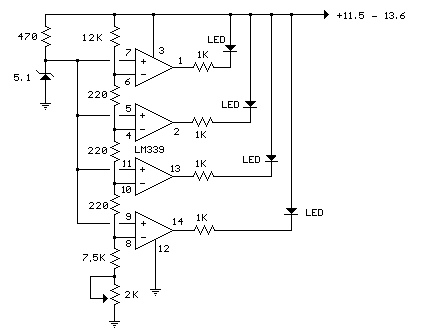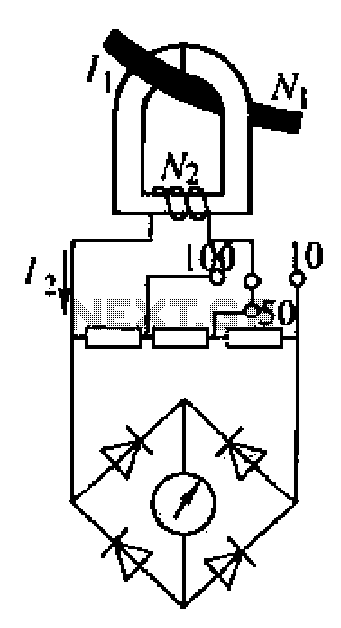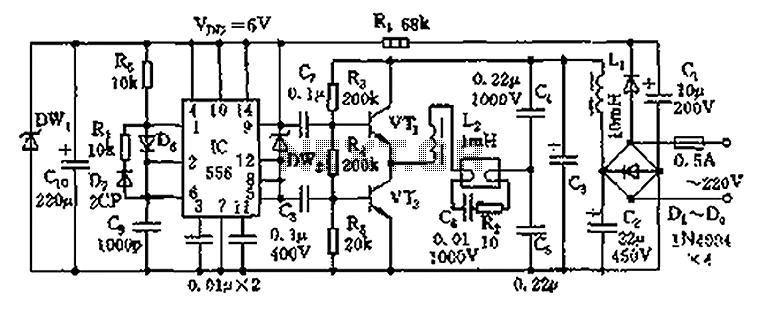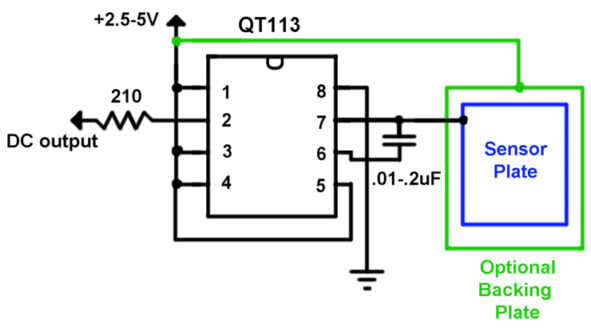
pulser 15hz 30khz zapper circuit
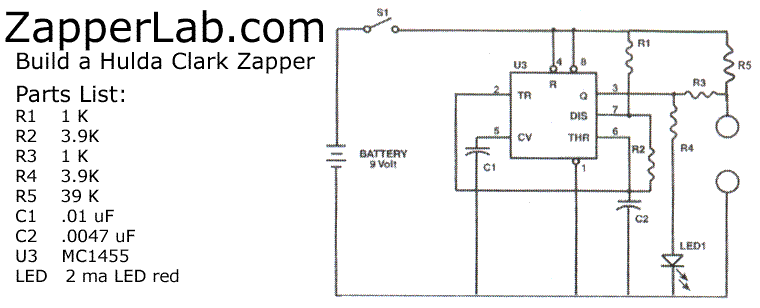
Modify a zapper circuit (similar to the Hulda Clark Zapper) to produce two different frequencies. One switch should be used to set the pulse to 15Hz, and another switch to set it to 30Hz. The nominal frequency for this circuit is 35kHz, not 30Hz. To halve the frequency, an additional 0.0047uF capacitor can be placed in parallel with C2. A switch can be added in series with the new capacitor if the intention is to toggle between the two frequencies. If 30Hz and 15Hz are required, some component values will need adjustment. The existing circuit was originally thought to operate at 30kHz, but the correct frequency is 35kHz. The goal is to generate square wave pulses that stimulate homeopathic medicines, enhancing their efficacy for individuals experiencing pain or severe infections. If the duty cycle is not critical, R1 can be modified to 2.4k to approximate the nominal frequency, although this will depend on component tolerances. It was noted that replacing R1 with a 2.4k resistor is a straightforward solution. The original circuit utilized a wave generator for research in homeopathy, sending generated waves into the medicine to improve results and prevent diseases. Improvements in frequency and power are desired, aiming to create a generator capable of producing frequencies from 2Hz to 2MHz, ideally allowing for frequency selection akin to a radio. The circuit's design is inspired by the late Dr. Royal Rife’s technology, which also involves frequencies and light, and is claimed by many to aid in healing. Homeopathic medicine operates with very small quantities of active substances, often considered merely water by scientists. The healing effect is attributed to energy frequency, creating a flow of energy through modulated scalar waves that energize the medicine, thereby enhancing its action. Although the zapper circuit yielded positive results, it is believed that a broader range and increased power through tube amplification could provide deeper therapeutic effects.
The proposed modification of the zapper circuit involves implementing a dual-frequency output to enhance its therapeutic applications. The circuit operates primarily at a nominal frequency of 35kHz, which can be adjusted to produce lower frequencies of 15Hz and 30Hz through strategic component modifications. The addition of a 0.0047uF capacitor in parallel with C2 effectively reduces the frequency, while a switch in series with this capacitor allows for easy toggling between the two operational frequencies.
To facilitate operation at both frequencies, a careful selection of resistor values is essential. Adjusting R1 to 2.4kΩ is recommended for fine-tuning the output closer to the desired frequencies, although the overall performance will still be influenced by the tolerances of the components used. It is critical to ensure that the circuit maintains stability and performance across the operational frequency ranges.
The circuit design also incorporates a square wave generator, which is crucial for stimulating homeopathic substances. The modulation of energy through square waves is believed to enhance the therapeutic properties of these medicines, making them more effective against various ailments. The integration of a wave generator for research purposes has shown promising results, indicating that further development of the circuit could yield significant advancements in homeopathic treatments.
The envisioned generator aims to cover a wide frequency range from 2Hz to 2MHz, allowing for versatile applications in therapeutic settings. This capability will enable users to select specific frequencies, similar to tuning a radio, thereby providing targeted treatment options. The exploration of frequencies inspired by Dr. Royal Rife’s work suggests a potential for deeper tissue penetration and enhanced healing effects, although regulatory considerations regarding the use of such devices must be acknowledged.
In conclusion, the circuit modification to achieve dual frequencies of 15Hz and 30Hz is a feasible project that could significantly improve the efficacy of homeopathic treatments. By carefully selecting and adjusting components, the zapper circuit can be optimized to deliver therapeutic energy effectively, potentially transforming the approach to energy-based healing methods.Modify a zapper circuit (like the Hulda Clark Zapper) to get two differente frequencies. One switch to make the pulse to 15Hz and the other to 30. 000Hz. The nominal frequency for that circuit is 35kHz (35, 000 Hz), not 30 Hz. You can cut the frequency in half by putting another 0. 0047uF cap in parallel with C2. Put a switch in series with the new cap if you want to be able to switch between the two frequencies. If you need 30 Hz and 15 Hz, some values need to be changed. Post here if that is what you want. I have this zapper circuit (that one with the link), I was "sure" that circuit had a 30KHz frequency, and you told me that the correct value is 35KHz (it was a surprise). The objective is a pulse of square waves to stimulates the homeophatic medicines and increase it`s power and get better results with people in pain or strong infections.
Zaanor, use the existing circuit for 30kHz. If duty cycle (pulse width to period ratio) isn`t critical, you can change R1 to 2. 4k to get closer to the nominal frequency. You will still be at the mercy of the component tolerances. Ron H is correct, I was off line doing the calculations myself. I calculated just like Ron H. Replace R1 with a 2. 4K. I chose not to use the electrolytic in place of C2. Instead if C2 is replaced with a 0. 47uf, R1 and R2 both become 68K. But here again Ron H`s solution is the easiest. This zapper was pluged into an wave generator for a research in homeophatics. We send these waves generated into the medicine for better results avoid the disesases. The results were great ! We want to try some improvements into frequency and power. So, we would like to make a generator from 2Hz or 5Hz until 2MHz, using tubes. It wuld be interesting is we can select the frequencies like a radio. I thought you were experimenting with the late Dr. Royal Rife`s technology as it also involve frequencies and lights and claimed by many people to heal medical conditions. The use of this not allowed by authorities in many countries. The homeophatic medicine, works with an active substance in a very small quantity. In fact the scientists use to say that there is no active priciple. just water. What make the medicine heal, is the energy frequency. So, we are making a flow of energy with modulated scalar waves from eletricity and by ressonance we make the medicine get an plus of energy acting faster.
The results with a zapper circuit was nice. but cannot affect deeply many people or diseses from a long time. It lacks in deep. We do believe that with a bigger range and more power (from the tubes) we can achieve this task. I need to modify a zapper circuit (like the Hulda Clark Zapper) to get two differente frequencies. One switch to make the pulse to 15Hz and the other to 30. 000Hz. I`ve heard about this 30KHz circuit designed to kill some bacterias of your organism. I havent read too much about this theme, but I`d like to know why you need different frequencies, 15 and 30 KHz. Perhaps you are confusing the simple zapper with an expensive Ultra-sound therapy machine that is used by real doctors.
Ultra-sound sends waves of energy deep into tissues and vibrates the tissues at the same 30kHz frequency. I suppose that the friction of vibration builds heat in the tissues. Then the body feels the heat and sends white blood cells and stuff to heal the problem. Other people posted the same circuit with an LED that would light and blink. It gave good results even though its zapper part of the circuit wasn`t powered. I also don`t think that a zap at 15Hz would do anything. Most likely you want to pulse the 30kHz at a 15Hz rate, using a 15Hz 555 circuit to gate another 30kHz 555 circuit on and off.
:lol: Perhaps you are confusing the simple zapper with an expensive Ultra-sound therapy machine that is used by real doctors. Ultra-sound sends waves of energy deep into tissues and vibrates the tissues at the same 30kHz frequency.
I s 🔗 External reference
The proposed modification of the zapper circuit involves implementing a dual-frequency output to enhance its therapeutic applications. The circuit operates primarily at a nominal frequency of 35kHz, which can be adjusted to produce lower frequencies of 15Hz and 30Hz through strategic component modifications. The addition of a 0.0047uF capacitor in parallel with C2 effectively reduces the frequency, while a switch in series with this capacitor allows for easy toggling between the two operational frequencies.
To facilitate operation at both frequencies, a careful selection of resistor values is essential. Adjusting R1 to 2.4kΩ is recommended for fine-tuning the output closer to the desired frequencies, although the overall performance will still be influenced by the tolerances of the components used. It is critical to ensure that the circuit maintains stability and performance across the operational frequency ranges.
The circuit design also incorporates a square wave generator, which is crucial for stimulating homeopathic substances. The modulation of energy through square waves is believed to enhance the therapeutic properties of these medicines, making them more effective against various ailments. The integration of a wave generator for research purposes has shown promising results, indicating that further development of the circuit could yield significant advancements in homeopathic treatments.
The envisioned generator aims to cover a wide frequency range from 2Hz to 2MHz, allowing for versatile applications in therapeutic settings. This capability will enable users to select specific frequencies, similar to tuning a radio, thereby providing targeted treatment options. The exploration of frequencies inspired by Dr. Royal Rife’s work suggests a potential for deeper tissue penetration and enhanced healing effects, although regulatory considerations regarding the use of such devices must be acknowledged.
In conclusion, the circuit modification to achieve dual frequencies of 15Hz and 30Hz is a feasible project that could significantly improve the efficacy of homeopathic treatments. By carefully selecting and adjusting components, the zapper circuit can be optimized to deliver therapeutic energy effectively, potentially transforming the approach to energy-based healing methods.Modify a zapper circuit (like the Hulda Clark Zapper) to get two differente frequencies. One switch to make the pulse to 15Hz and the other to 30. 000Hz. The nominal frequency for that circuit is 35kHz (35, 000 Hz), not 30 Hz. You can cut the frequency in half by putting another 0. 0047uF cap in parallel with C2. Put a switch in series with the new cap if you want to be able to switch between the two frequencies. If you need 30 Hz and 15 Hz, some values need to be changed. Post here if that is what you want. I have this zapper circuit (that one with the link), I was "sure" that circuit had a 30KHz frequency, and you told me that the correct value is 35KHz (it was a surprise). The objective is a pulse of square waves to stimulates the homeophatic medicines and increase it`s power and get better results with people in pain or strong infections.
Zaanor, use the existing circuit for 30kHz. If duty cycle (pulse width to period ratio) isn`t critical, you can change R1 to 2. 4k to get closer to the nominal frequency. You will still be at the mercy of the component tolerances. Ron H is correct, I was off line doing the calculations myself. I calculated just like Ron H. Replace R1 with a 2. 4K. I chose not to use the electrolytic in place of C2. Instead if C2 is replaced with a 0. 47uf, R1 and R2 both become 68K. But here again Ron H`s solution is the easiest. This zapper was pluged into an wave generator for a research in homeophatics. We send these waves generated into the medicine for better results avoid the disesases. The results were great ! We want to try some improvements into frequency and power. So, we would like to make a generator from 2Hz or 5Hz until 2MHz, using tubes. It wuld be interesting is we can select the frequencies like a radio. I thought you were experimenting with the late Dr. Royal Rife`s technology as it also involve frequencies and lights and claimed by many people to heal medical conditions. The use of this not allowed by authorities in many countries. The homeophatic medicine, works with an active substance in a very small quantity. In fact the scientists use to say that there is no active priciple. just water. What make the medicine heal, is the energy frequency. So, we are making a flow of energy with modulated scalar waves from eletricity and by ressonance we make the medicine get an plus of energy acting faster.
The results with a zapper circuit was nice. but cannot affect deeply many people or diseses from a long time. It lacks in deep. We do believe that with a bigger range and more power (from the tubes) we can achieve this task. I need to modify a zapper circuit (like the Hulda Clark Zapper) to get two differente frequencies. One switch to make the pulse to 15Hz and the other to 30. 000Hz. I`ve heard about this 30KHz circuit designed to kill some bacterias of your organism. I havent read too much about this theme, but I`d like to know why you need different frequencies, 15 and 30 KHz. Perhaps you are confusing the simple zapper with an expensive Ultra-sound therapy machine that is used by real doctors.
Ultra-sound sends waves of energy deep into tissues and vibrates the tissues at the same 30kHz frequency. I suppose that the friction of vibration builds heat in the tissues. Then the body feels the heat and sends white blood cells and stuff to heal the problem. Other people posted the same circuit with an LED that would light and blink. It gave good results even though its zapper part of the circuit wasn`t powered. I also don`t think that a zap at 15Hz would do anything. Most likely you want to pulse the 30kHz at a 15Hz rate, using a 15Hz 555 circuit to gate another 30kHz 555 circuit on and off.
:lol: Perhaps you are confusing the simple zapper with an expensive Ultra-sound therapy machine that is used by real doctors. Ultra-sound sends waves of energy deep into tissues and vibrates the tissues at the same 30kHz frequency.
I s 🔗 External reference
Warning: include(partials/cookie-banner.php): Failed to open stream: Permission denied in /var/www/html/nextgr/view-circuit.php on line 713
Warning: include(): Failed opening 'partials/cookie-banner.php' for inclusion (include_path='.:/usr/share/php') in /var/www/html/nextgr/view-circuit.php on line 713

